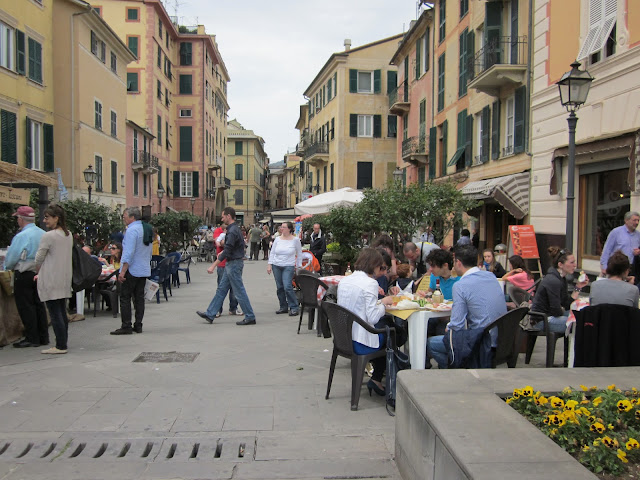CHIAVARI,
Italy – A friend of mine once told me that it isn’t spring in Italy until the fava
beans are in the market. Well, it must be spring because at yesterday’s mega May
Day food fest in Rapallo, fava beans were the stars of the show. Everywhere I
looked I saw families happily shelling piles of fava beans to eat with a little
pecorino cheese and slices of local salami.
I
don’t know if they sell unshelled fava beans in the markets in the States now,
I know they didn’t when I lived there. I don’t know why they have never caught
on, it may be because it takes time to shell fava beans, and time seems to be
the one thing that is always in short supply.
Fava
beans in their pods look like overgrown bumpy string beans. They are 5 to 7
inches long and the inside of the pod is lined with what looks like white
velvet. When you buy fava beans, look for green pods that are not bulging,
bulging pods are older pods and the beans tend to have a slightly bitter taste.
Favas should have a sweet, nutty taste, which is why they go so well with the
sharp flavor of pecorino cheese.
Also,
you have to buy a lot of them because the beans are shelled twice. One pound of
un-peeled favas will only give you about 1/3 cup of beans. Here’s how you do
it: Simply
split the pod open and take out the beans. There
are about 4 to 5 beans per pod. You will see that the just shelled beans have a
thick skin around them, and that needs to be peeled off as well. There are
cooks who say you can eat the beans with the skin on them if you cook them thoroughly,
but if you are going to eat them raw, which is the way they are meant to be
eaten if you are pairing them with pecorino and salami, you need to peel off the
second skin.
here
are two ways to do this. The first way is to make a small cut with a knife
along the edge of the bean and pop the inner bean out of its skin. The Italians
suggest boiling them for 3 or 4 minutes, or, you can blanch the fava beans by
putting them in boiling salted water for about 30 seconds, take them out and immediately
put them in ice cold water to stop the cooking process. The boiling and/or 30
second blanching softens the inner skin making it easier to remove. Then you
just squeeze the bean out of its skin.
Not
complicated, but it does take a little time. The families I saw in Rapallo yesterday
didn’t seem to be in a hurry as they shelled and ate beans, nibbled on cheese
and salami and sipped a little red wine. They seemed to be having a grand time
doing it.
Fave
with pecorino, even without salami, is a great antipasto and a variation of the
recipe below. They are both worth trying when fave are in season.
 |
| May Day in Rapallo |
You
have to be careful not to overpower the delicate taste of the fave. I saw some
truly frightening treatments of fava beans on YouTube this morning, like
drowning them in olive oil and apple cider vinegar, or pairing them with spicy
hot peppers, and, and I don’t even want to tell you the rest as I got goose bumps
just thinking about what was happening to them.
The
truth is, and this is true of so many Italian recipes, this is such a simple
dish to prepare it doesn’t even feel like cooking, and yet it is Italian
cooking at its best.
Typical Roman Fave
and Pecorino Antipasto
Serves 4
400 g. fresh, shelled
fava beans
250 g. pecorino Romano
400 g. mixed salad
greens,
include slightly bitter
ones like rucola (the original recipe
calls for mixed field greens, including dandelion, which you can buy in Italy
in any village vegetable stand in the spring).
1 spring onion
8 slices of country
style Italian bread
Extravirgin olive
oil, salt, balsamic vinegar
Toast
the bread slices. Clean the onion and slice it into rounds. Rinse the salad
greens and dry them, and put them in a large serving bowl. Sprinkle with salt, a
drizzle of extravirgin olive oil and a little balsamic vinegar. Serve the salad
with the toasted bread, the fresh fave beans and shavings of pecorino Romano.
p.s. if you happen to buy really fresh, really young fava beans you don't have to shell them twice, just eat the whole bean and enjoy.
p.s. if you happen to buy really fresh, really young fava beans you don't have to shell them twice, just eat the whole bean and enjoy.



No comments:
Post a Comment